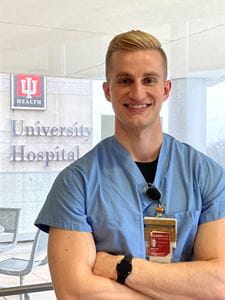When Indiana University School of Medicine general surgery resident, Jackson Baril, MD, was in college at University of Minnesota, he encountered a couple life-changing experiences: he registered for Be the Match to donate peripheral blood stem cells and decided to donate a kidney.
The journey began innocently enough, as there was someone on campus to encourage people to sign up to donate bone marrow. And in a tissue engineering class, he learned about the need for organs.
“I encourage everyone to get on the donor registry!” Baril said enthusiastically, about Be the Match. “It is so important to have a large, diverse pool of potential donors to find the match for patients who need a transplant. It's a collective effort! Every person added to the registry helps. I was just lucky enough to be called up from the list to help someone.”
The likelihood of matching on the Be the Match registry ranges between 29-79 percent, depending on patient ethnic background. About 70 percent of patients who need a bone marrow transplant do not have a donor match within their family, according to Be the Match.
Baril donated peripheral blood stem cells where an apheresis machine separates stem cells from other types of blood cells. He said the procedure can 3 to 8 hours and his took 8 hours.
When considering donating his kidney, his family was curious at first why he wanted to donate but felt more at ease once they heard more about the process.
“I’d do it in an instant for a brother and sister,” Baril reasoned. “Why wouldn’t I do it for someone else?”
He appreciated the flexibility in planning lab appointments to donate.
His former colleague and chief resident, Kyle Carpenter, MD, who is now an adult surgical critical care fellow at Michigan Medicine, said that Baril demonstrates the attitude of people to work as a team.
“He knows where there are gaps and fills in where needed,” Carpenter said.
Signe Braafladt, MD, his peer in the general surgery resident program at IU, recognized Baril’s donation process was straight-forward and convenient.
“From my perspective it seemed like an easy process to participate,” Braafladt said. “He left for a short period to get labs one day and then was gone to donate for a couple days. Our chief was very supportive and Jackson was excited to talk about how his donation would help someone. Jackson is a very kind, motivated, and intelligent colleague and I’m always happy to work with him.”
Baril contributes to surgery cases according to his residency level. In the past, he’d help with laparoscopic surgeries and had enjoyed his transplant rotation.
He said he has an interest in transplant and really likes trauma and critical care.
“The more I go through residency, every attending is an expert in their own right,” Baril said.
###
